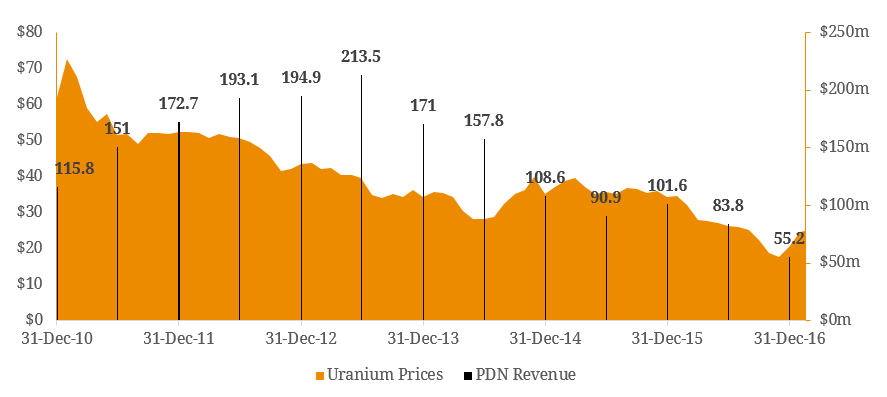Along with most uranium miners, Paladin Energy (ASX: PDN) has faced increased pressure from decade-low uranium prices and over-supply of yellowcake (impure uranium oxide obtained during processing of uranium ore). With soft top-line growth and failure to sell a 24% stake of its flagship Langer Heinrich mine putting downwards pressure on its liquidity, the company has proposed a balance sheet restructure to stay afloat. The proposal to restructure will attempt to reduce Paladin’s debt obligations and extend the group’s debt maturity profile. Figure 1: Uranium Commodity Prices and Reported Revenue for PDN  Source: Bloomberg, Company Reports, BondAdviser Paladin now owns 75% of the low-cost Langer Heinrich mine, the world’s fourth largest open pit uranium mine, along with a number of pipeline uranium deposits and projects located in Australia and Canada. The group had a net current asset deficit of US$173.5 million (as on 31 December 2016) indicating that it does not have sufficient funds to pay back the holders of its US$212 million convertible bonds due 30 April 2017. The capital restructure proposes the exchange of its existing 2017 convertible bonds (US$212 million) and 2020 convertible bonds (US$150 million) into US$115 million of new secured bonds due 2022, US$102 million of new 2024 convertible bonds and US$145 million of Paladin shares. Figure 2: Impact of Restructure on PDN’s Debt Profile
Source: Bloomberg, Company Reports, BondAdviser Paladin now owns 75% of the low-cost Langer Heinrich mine, the world’s fourth largest open pit uranium mine, along with a number of pipeline uranium deposits and projects located in Australia and Canada. The group had a net current asset deficit of US$173.5 million (as on 31 December 2016) indicating that it does not have sufficient funds to pay back the holders of its US$212 million convertible bonds due 30 April 2017. The capital restructure proposes the exchange of its existing 2017 convertible bonds (US$212 million) and 2020 convertible bonds (US$150 million) into US$115 million of new secured bonds due 2022, US$102 million of new 2024 convertible bonds and US$145 million of Paladin shares. Figure 2: Impact of Restructure on PDN’s Debt Profile  Source: Company Reports, BondAdviser In total, the restructure would result in a $US145 million debt reduction, and allow for financial flexibility to refocus its operations. However, it would also likely result in the issue of at least $75 million in equity through 5 billion new shares (on top of the 1.7 billion shares currently outstanding). On the flip-side, the cost of debt is typically less than that of equity as debt-holders have a superior claim over the company’s assets (i.e. less risk). In addition, interest on debt brings down taxable income, reducing the tax expense and supporting earnings. For a company not anticipating exceptional growth, this restructure could come at the cost of shareholders in the long-term. However, management expects the normalisation of the uranium market to be imminent. With the company effectively optimising operating and exploration costs, this restructure provides an all-inclusive solution that provides a stable and sustainable capital structure for the benefit of all stakeholders in the short to medium term. The company needs 75% of each group of bondholders to approve the plan. As of 14th February 2017, bondholders representing 71.6% of the 2017 convertible bonds and 45.9% of the 2020 convertible bonds have signed undertakings to support the restructure.
Source: Company Reports, BondAdviser In total, the restructure would result in a $US145 million debt reduction, and allow for financial flexibility to refocus its operations. However, it would also likely result in the issue of at least $75 million in equity through 5 billion new shares (on top of the 1.7 billion shares currently outstanding). On the flip-side, the cost of debt is typically less than that of equity as debt-holders have a superior claim over the company’s assets (i.e. less risk). In addition, interest on debt brings down taxable income, reducing the tax expense and supporting earnings. For a company not anticipating exceptional growth, this restructure could come at the cost of shareholders in the long-term. However, management expects the normalisation of the uranium market to be imminent. With the company effectively optimising operating and exploration costs, this restructure provides an all-inclusive solution that provides a stable and sustainable capital structure for the benefit of all stakeholders in the short to medium term. The company needs 75% of each group of bondholders to approve the plan. As of 14th February 2017, bondholders representing 71.6% of the 2017 convertible bonds and 45.9% of the 2020 convertible bonds have signed undertakings to support the restructure.

